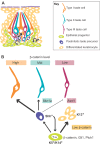Progress and renewal in gustation: new insights into taste bud development
- PMID: 26534983
- PMCID: PMC4647210
- DOI: 10.1242/dev.120394
Progress and renewal in gustation: new insights into taste bud development
Abstract
The sense of taste, or gustation, is mediated by taste buds, which are housed in specialized taste papillae found in a stereotyped pattern on the surface of the tongue. Each bud, regardless of its location, is a collection of ∼100 cells that belong to at least five different functional classes, which transduce sweet, bitter, salt, sour and umami (the taste of glutamate) signals. Taste receptor cells harbor functional similarities to neurons but, like epithelial cells, are rapidly and continuously renewed throughout adult life. Here, I review recent advances in our understanding of how the pattern of taste buds is established in embryos and discuss the cellular and molecular mechanisms governing taste cell turnover. I also highlight how these findings aid our understanding of how and why many cancer therapies result in taste dysfunction.
Keywords: Ageusia; Cell lineage; Chemotherapy; Dysgeusia; Gustatory system; Lingual organoids; Molecular genetics; Sonic hedgehog; Stem cells; Taste buds; Taste dysfunction; Wnt/β-catenin.
© 2015. Published by The Company of Biologists Ltd.
Conflict of interest statement
The author declares no competing or financial interests.
Figures



References
Publication types
MeSH terms
Grants and funding
LinkOut - more resources
Full Text Sources
Other Literature Sources

